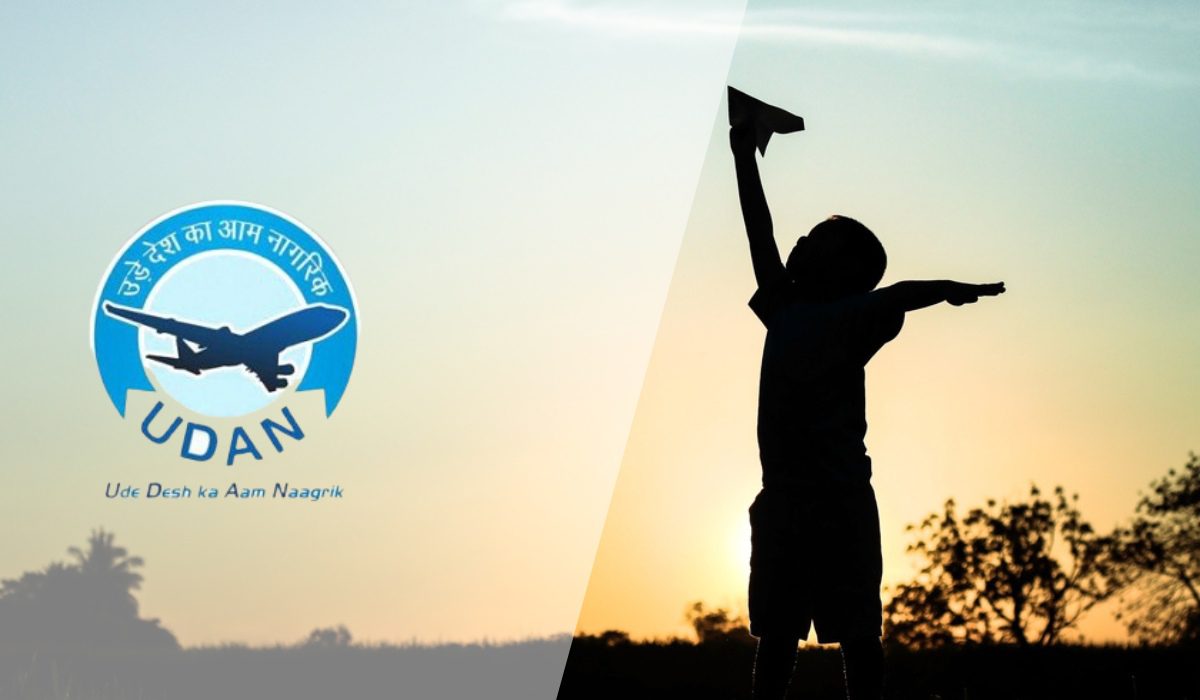To make air travel affordable and widespread, the central government has launched the UDAN Scheme. Through this, various kinds of measures are taken to boost air travel. This article covers all the important information regarding the UDAN Scheme and advantages associated with it. So, read on to know details regarding its implementation procedure.
UDAN Scheme: Overview
Standing for ‘Ude Desh Ka Aam Naagrik’, UDAN is a regional airport development programme initiated by the central government, forming a crucial part of the Regional Connectivity Scheme (RCS). It aims to upgrade under-serviced air routes with the primary objective of rendering air travel more affordable and fostering economic development across India. At the inception of the scheme, among a total of 486 airports, 406 were classified as under-serviced, with merely 27 being adequately served. Additionally, out of 97 non-RCS airports, only 12 were operational. The UDAN scheme was devised to augment these figures by accelerating the development and operationalisation of approximately 425 unserved, under-served and largely underdeveloped regional airports, facilitating regular scheduled flights.
UDAN Scheme: Key facts
| Name of scheme | Ude Desh Ka Aam Naagrik (UDAN) |
| Launched on | October 21, 2016 |
| Launched by | Government of India |
| First flight launched on | April 27, 2017 |
| Beneficiary | Citizens of India |
| Funding | Viability Gap Funding |
UDAN Scheme: Objectives
The two main objectives of the UDAN Scheme are given below.
- Affordable airfares: A key aim of the scheme is to reduce the cost of air travel for individuals across all income brackets. By capping airfares for a set number of seats on specific routes, the programme aims to enhance accessibility and affordability. This initiative is particularly beneficial in regions with limited alternative transportation options, encouraging greater adoption of air travel.
- Rural connectivity: The UDAN programme provides Viability Gap Funding to facilitate airlines in operating flights to underserved and rural airports in a financially sustainable manner. Under this scheme, airlines receive financial assistance from the government in the form of subsidies and reduced operating risks for flights on less lucrative routes. This incentivises and supports airline companies in establishing connections to remote areas that may not be economically viable otherwise.
UDAN Scheme: Features
The UDAN Scheme spans a duration of 10 years, and participating airlines are selected through a competitive bidding process.
Support offered by central government
- Subsidy to cover Value Gap Funding (VGF) for airlines taking part in the scheme
- Code sharing opportunities for flights under the policy
- Concessional GST on tickets booked through the scheme
Support offered by state government
- Coordination with oil companies to facilitate refuelling
- 20% of VGF
- GST reduction to 1% for 10 years
- Provision of land for airport and ancillary development
- Utilities at subsidised rates
- Trained security personnel
Support offered by airport operators like AAI
- Nil Terminal Navigation Landing Charges (TNLC)
- No parking, storage, or landing charges at participating airports
- Discounted Route Navigation and Facilitation Charges (RNFC) to 42.4% of normal rates by the AAI
- Ground handling by the airline selected through the bidding process
UDAN Scheme: Phases
The UDAN Scheme has been and is still being implemented in phases.
UDAN 1.0
During this phase, 128 flight routes to 70 airports (including 36 newly constructed airports) were granted to five airline companies.
UDAN 2.0
In 2018, the Ministry of Civil Aviation identified 73 underserved and unused airports. Helipads were connected for the first time as part of the UDAN scheme in this phase.
UDAN 3.0
Additional tourism routes were established with the help of the Ministry of Tourism in this phase. Seaplanes were introduced to link water/ocean airfields, and more air routes were introduced to the North-East region.
UDAN 4.0
Launched in December 2019 to serve islands, hilly states, and the northeastern regions specifically. Airports managed by AAI received higher consideration for VGF grants. Helicopter and seaplane operations were also included.
UDAN 5.0
Launched on 21 April 2023 with the following key objectives.
- Eligibility is restricted to Category 2 (20 to 80 seat) and Category 3 (>80 seat) aircraft operations.
- The previous 600 km stage length limit for flights between sources and destinations has been lifted.
- The former 500 km cap on VGF for both priority and non-priority sectors has been raised to 600 km.
- Airlines cannot be allocated the same route more than once, within the same network or across networks.
- Only network and individual route proposals will be evaluated, and airlines must submit an action/business plan within two months after acquiring the Letter of Authorization (LOA).
- Exclusivity terminates if the quarterly passenger load factor exceeds 75% for four consecutive quarters to prevent route monopoly misconduct.
- After the route is awarded, airlines must start operating within four months from the previous deadline of six months.
- To promote early operationalisation, cash 25% of the Performance Guarantee for every month of delay, up to a maximum of four months.
- The procedure of novation for routes between operators is made more straightforward and rewarding.
UDAN-RCS Price Structure
Here is the UDAN-RCS price structure.
Maximum fare cap
- Only half of the plane seats will have a price limit, with the remaining half sold at standard market price.
- Fixed-wing aircraft have a maximum fee of Rs 2,500 per hour of flight.
- The minimum number of RCS seats is nine, and the maximum capacity is forty per fixed-wing aircraft.
- For helicopter travels, the maximum number of RCS seats is 12.
- The cost for a 30-minute helicopter ride is fixed at Rs 2,500, irrespective of the distance travelled.
Graded fare-based on distance
- The capped RCS rates will be scaled according to the distance of the flight.
- The graded fare remains dependent on the distance travelled.
- The highest rate is Rs 1,420 for a trip of 151 km to 175 km and Rs 1,500 for a trip of 176 km to 200 km. The capped helicopter fare is graded based on the time duration of the flight. For example, the fare is Rs 2,500 for a flight lasting 0 to 30 minutes and for flights lasting 31 to 35 minutes, the fare is Rs 2,900.
- The cost varies with the distance travelled.
- The graded fare continues based on the duration of the flight.
Maximum fare limit
- This establishes an upper limit for the highest fare, independent of the actual distance travelled.
- The maximum cost for a total journey of 800 km or more is Rs 3,500.
- For helicopter services, the highest fare limit is Rs 5,000 for the entire flight length, regardless of leg durations.
UDAN Scheme: Achievements
According to data released in August 2022 by the Ministry of Civil Aviation:
- The number of operational airports has risen from 74 in 2014 to 141.
- The UDAN Scheme has significantly improved air connectivity to Tier-2 and Tier-3 cities, providing affordable airfares and transforming travel.
- Under the UDAN Scheme, 68 underserved/unserved destinations, including 58 airports, eight heliports, and two water aerodromes, have been linked.
- More than one crore passengers have benefitted from this scheme, enjoying its advantages.
- With the addition of 425 new routes, UDAN has facilitated air connectivity to over 29 states and union territories.
UDAN Scheme: Challenges
- The poor financial health of many smaller regional carriers has hindered the scheme’s progress.
- Many operators have only one or two planes, highlighting the need for addressing this issue. Access to new aircraft needs to be facilitated for these smaller players.
- Routes awarded under UDAN may not necessarily be viable or functional.
- The scheme’s failure is largely attributed to its market-driven nature, requiring the government to enhance route profitability for airline operators.
- Smaller airlines face challenges in competing with larger carriers for pilots and other personnel, who demand salaries on par with major carriers despite operating on a smaller scale.
- Bids under UDAN are based on the airline operators’ demand assessment for specific routes.
In a nutshell
The UDAN Scheme, initiated by the government as part of the Regional Connectivity Scheme, aims to upgrade under-serviced air routes to make air travel more affordable and foster economic development across the country. Through various measures such as Viability Gap Funding, concessional taxes, and support from both central and state governments, UDAN strives to enhance accessibility to air travel, particularly in Tier-2 and Tier-3 cities and connect underserved areas. The scheme has undergone multiple phases of implementation, aiming to link more airports, introduce new routes and enhance connectivity. Despite its achievements in increasing the number of operational airports, improving air connectivity, and benefiting passengers, UDAN faces challenges, such as financial viability for smaller regional carriers and ensuring the functionality of awarded routes.
(The logo used on the featured image is the sole property of the Governmnet of India)
FAQs
What is the UDAN Scheme?
The UDAN Scheme, or 'Ude Desh Ka Aam Naagrik', is a regional airport development programme launched by the Government of India to enhance air connectivity and make air travel more affordable and accessible across the country.
When was the UDAN Scheme launched?
The UDAN Scheme was launched on October 21, 2016, by the Government of India.
Who can benefit from the UDAN Scheme?
The UDAN Scheme benefits citizens of India by providing affordable airfares and improved air connectivity, particularly to Tier-2 and Tier-3 cities.
How long does the UDAN Scheme last?
The UDAN Scheme spans a duration of 10 years, aimed at sustainable development and improving the regional air connectivity.
What are the main objectives of the UDAN Scheme?
The main objectives of the UDAN Scheme are to provide affordable airfares to individuals across all income brackets and enhance rural connectivity by facilitating flights to underserved and rural airports with Viability Gap Funding support.
| Got any questions or point of view on our article? We would love to hear from you. Write to our Editor-in-Chief Jhumur Ghosh at jhumur.ghosh1@housing.com |

Dhwani is a content management expert with over five years of professional experience. She has authored articles spanning diverse domains, including real estate, finance, business, health, taxation, education and more. Holding a Bachelor’s degree in Journalism and Mass Communication, Dhwani’s interests encompass reading and travelling. She is dedicated to staying updated on the latest real estate advancements in India.
Email: dhwani.meharchandani@housing.com












